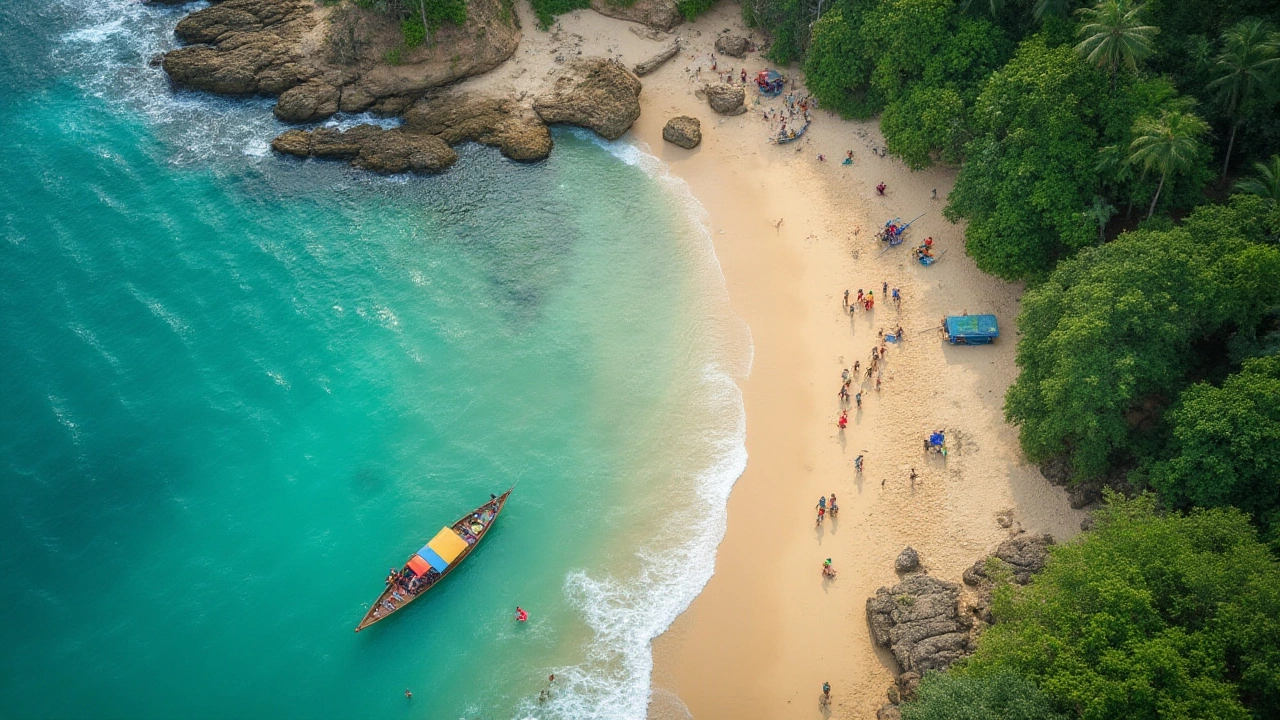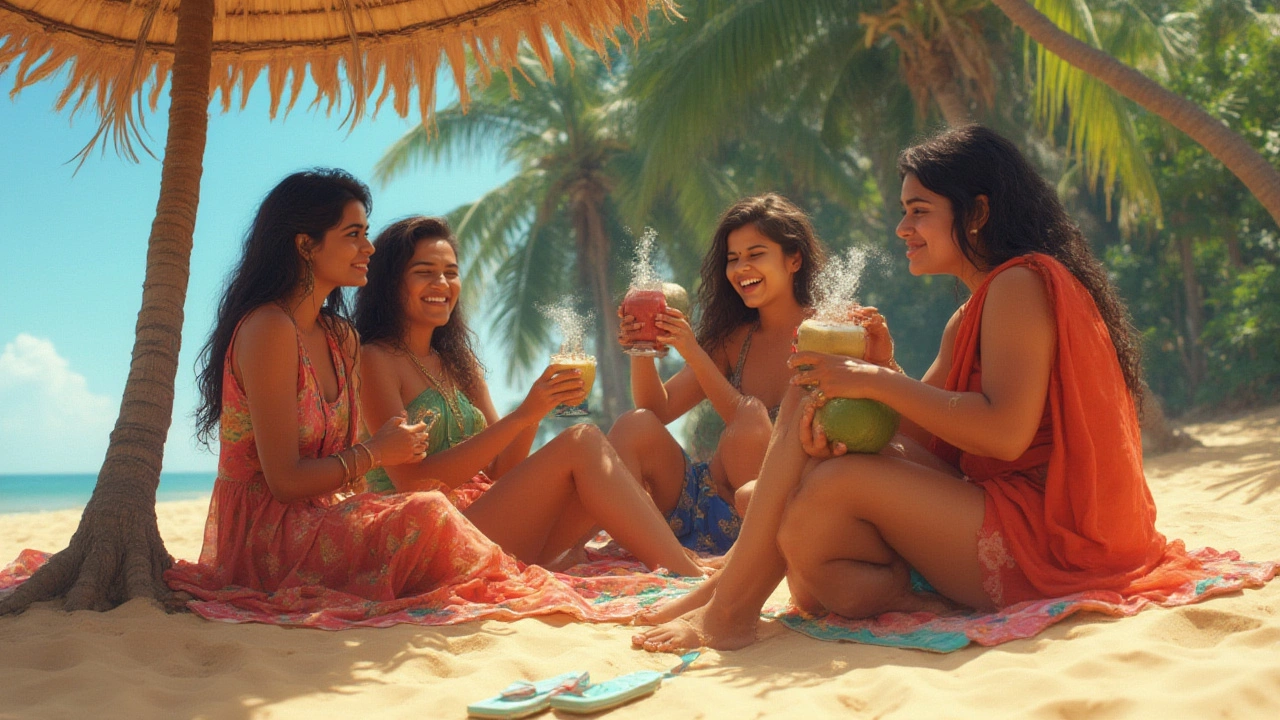Sometimes, you catch a whiff of salty air and just know you need sand beneath your toes. But if you had to pick only one Indian beach to write about, the answer surprises even seasoned travelers. It isn't Goa (though it tries hard). Instead, the crown lands gently on Radhanagar Beach in the Andaman and Nicobar Islands. The turquoise water here isn’t a Photoshopped cliché, it’s real and rolls in every day, brushing powder-soft sand that squeaks underfoot. Tourists say it looks like something out of a screensaver, but honestly, the reality beats any digital wallpaper. Why is Radhanagar Beach considered the best? Let’s unravel why this stretch of shoreline wins, time and time again.
Radhanagar Beach: The Unrivaled Gem of India
Radhanagar Beach sits on the Havelock Island of the Andaman and Nicobar Islands, a territory floating east of mainland India in the Bay of Bengal. This beach shot to fame when Time Magazine named it Asia’s best beach in 2004—and it’s never quite tumbled from its pedestal. What really sets Radhanagar apart from mainland hotspots like Baga or Kovalam is its stunning tranquility. Imagine a strip of white, almost creamy sand. It’s lengthy enough—about 2 kilometers—that even in peak season, you can usually claim your own patch. And the sunsets? The orange-pink sky hangs behind tall tropical trees, reflecting in waters so clear you can spot your toes even when it’s waist-deep.
If you’re a fan of clean beaches, here’s something concrete: Radhanagar Beach has Blue Flag status, a badge awarded for eco-friendliness and water quality, only given to a handful in India. Lifeguards are present, and you won’t find the usual mess of shacks, sellers, or bumping music; the government keeps vendors away and enforces spotless cleanliness. Sometimes, you spot playful elephants being led along the sand, which only adds to the fairytale vibe.
Looking for action? While most come to paddle, sunbathe, or laze, the warm shallows are perfect for swimming. The nearby shallow reef supports thriving coral and schools of parrotfish, so snorkelers don’t need to venture far. The best time to visit is between November and May, outside the monsoon window, when the sea stays calm and the humidity drops. Here’s a fun fact—and this floors most people—Havelock Island changed its name recently; it’s now officially called Swaraj Dweep. But don’t panic, everyone still refers to Radhanagar by its classic name.
Let’s give you something to chew on. Here’s a quick look at why Radhanagar hits all the right notes in a sea of Indian beaches:
| Feature | Radhanagar Beach | Typical Mainland Beaches |
|---|---|---|
| Sand Quality | White, ultra-fine | Yellow/golden, coarse |
| Water Clarity | Crystal clear, blue-green | Cloudy, sometimes rough |
| Crowd Level | Low to moderate | High (esp. weekends) |
| Cleanliness | Blue Flag | Varies |
| Commercialization | Minimal | High |
| Best Visiting Months | Nov-May | Dec-Feb |
How Does Radhanagar Stack Up Against Goa, Kerala, and Other Hotspots?
Goa’s Calangute and Palolem, Kerala’s Varkala and Kovalam, and Karnataka’s Gokarna—they all have a vibe. Goa is a feast of color, coconut palms, endless beach shacks, live jazz, and partiers in tie-dye. The beaches are good for a walk, a football game, or a fresh lime soda. But anyone seeking peace knows that in high season, it gets stuffed. The same goes for Varkala’s long clifftop promenade, with its yoga studios and smoothie stalls. It’s an experience but rarely “peaceful.”
What makes Radhanagar Beach rise above is the sheer sense of wilderness. Not a wild party—actual wild. You hear jungle birds, watch hermit crabs scuttling, and catch an occasional deer dashing between sea almonds on the edge of the forest. Just for pale stats fans, Goa alone attracts over 7 million tourists yearly, most heading for Baga, Candolim, and Palolem. In contrast, the Andaman Islands as a whole see around 500,000 visitors a year—and fewer make it past Port Blair, so Havelock never feels overcrowded.
If you want safe, shallow water fit for kids, then again, Radhanagar wins—because there’s hardly any riptide. Most of India’s west coast beaches can get rough and the undercurrent sneaky in the afternoons. In Kerala and Goa, sometimes you get beach dogs or stray cows, but in Radhanagar, you might see a deer wander onto the sand, or the famous Rajan, the swimming elephant (who, sadly, passed away in 2016 but is still fondly remembered by locals).
South India’s famous Marina Beach (Chennai) wins for length—the world’s second-longest urban beach—but with more people, more city, and less swimmable water. Radhanagar, by contrast, maintains a balance: naturally wild but safely managed, relaxed, and yet polished by careful regulation. If you want a resort, you’ll get it—there are about a dozen tucked into the forest bordering the beach—without ruining the peace with loud bars or nightclubs.
In short: Radhanagar takes the top spot because it gives you space, pure shores, and that rare feeling you’ve gone somewhere truly special. The beach is famous but not trashed by its own popularity.

Insider Tips for Visiting Radhanagar Beach
All right, you might be planning a trip right now—so here’s what you need to know. Havelock Island/Swaraj Dweep is only accessible by ferry (or a bumpy government seaplane!). Fast catamaran ferries from Port Blair take about 90 minutes. You need to get permits (easy to arrange online or through your hotel, and included for most foreign tourists on arrival in Port Blair). Ferries can sell out quickly, especially in the December-January rush, so book ahead. There’s no airport on Havelock Island itself—nearest is Port Blair (Veer Savarkar International Airport), well connected with Delhi, Kolkata, and Chennai.
The beach opens at sunrise and closes by sunset, as per island rules, so it isn’t a place for late-night beach bonfires. Police keep a pretty tight watch for safety. There are no plastic bottles allowed, and you’ll find bins signposted every fifty meters. Bring your swimwear, sunscreen, and a reusable water bottle—you’ll get filtered water refills for a tiny fee. Don’t be surprised if monkeys try to open your bag for snacks, and definitely don’t feed them.
If you fancy adventure, try guided snorkeling or sign up for a beginner’s scuba session. Most operators use eco-friendly gear and are certified with PADI or SSI. Just keep in mind that the coral reefs at Elephant Beach and nearby Neil Island are in better health for more colorful marine life, but the water at Radhanagar is so clear you’ll see plenty without much effort. The sunsets at Radhanagar are legendary. Locals gather around 5 p.m. with snacks and camera phones ready. Don’t rush off when the sun drops—it’s worth sitting quietly until the afterglow, when every photo turns out dreamy without even trying.
One quirky thing: there are no changing rooms or showers directly on the beach—these are located near the parking lot, a few minutes’ walk away (so keep that in mind with little ones). Mobile signal might cut out on some stretches, but that’s half the point, right?
If you’re after pure chill, consider staying at one of the eco-resorts nearby. Most are low-rise, wooden lodges nested among coconut palms—with wild orchids and butterflies for neighbors. Be prepared to disconnect from the “real” world, not by force but, happily, by choice.
What to Eat, See, and Pack for the Ultimate Radhanagar Experience
Here’s where you win: seafood. The Andamans are a seafood paradise, and most resorts will grill up red snapper, prawns, or lobster—usually served with local greens, coconut rice, and chutneys. Vegetarians, no worries; there’s plenty of Bengali and South Indian-style veg plates made with fresh produce. Eating at the beach is forbidden to keep the place clean, but you’ll find plenty of sit-down restaurants and small cafes just two minutes’ walk back from the shore.
If you’re itching for activity beyond lazing, hire a bike or scooter. The ride from the central market to the beach meanders through paddy fields, forests full of birdsong, and villages with blue-roofed houses. Stop at one of the island’s organic coconut stalls—it’ll taste better than any bottled drink, and hey, there’s no plastic footprint.
Ready to hit the water? Pack good-quality reef-safe sunscreen (normal stuff isn’t great for the coral). Flipflops or barefoot-friendly sandals are best—no fancy footwear needed. Jellyfish visits are rare here, but for the cautious, a light rash vest is handy. Bring a wide-brimmed hat and polarized sunglasses; the sun can be deceptively strong. Bug spray helps at dusk. Don’t pack loudspeakers or drones—the authorities crack down on noise and privacy violations. Instead, a waterproof camera or a GoPro is ideal for taking home those underwater shots.
You can opt for a guided mangrove kayak tour at dawn if you want to feel even more cut off from modern life. The Andamans are also nesting grounds for leatherback turtles, especially in winter—sometimes you’ll spot tracks in the sand or even baby turtles racing for the sea (a sight you’ll remember forever).
Remember, alcohol isn’t served on or around the actual beach itself but is available in most resorts and licensed places in the village.

The Stories, Legends, and Local Life that Make Radhanagar Unique
Ask locals, and you’ll hear that Radhanagar was once just a tiny fishing hamlet—now it's the heartbeat of Havelock’s gentle tourism. The folks here have a quiet pride, fiercely protective of their home. Every evening, as the sun drops, you’ll see local women sweeping the shore with handmade coconut-leaf brooms, and on weekends, whole families pitch in to clear driftwood or loose seaweed. Storytelling is woven into the place; some elders talk of hidden treasures and shipwrecks from British colonial times, while island kids spend ages spotting eagle rays and wild kingfish darting past the rocks.
A fun local custom: during holidays, you might spot flower garlands hanging on driftwood, placed by families for good luck by the sea. The Andaman and Nicobar Islands are also an ethnic melting pot—Bengalis, Tamilians, indigenous Nicobarese, and mainland settlers have each left their food, song, and even beach games (cricket on sand is a favorite!).
If you wake up early, local fishers may invite you to watch them haul in nets the old way, with rhythmic chants and bare hands—no heavy engines, no noise, just community. Those who wander into the forest behind Radhanagar will find that the island’s rare Andaman wild pigs and deer mind their business but aren’t shy.
It’s this mixture of careful conservation, real welcome, and natural beauty that clinches the number one spot for No 1 beach in India. Visitors come expecting just a beautiful beach and leave raving about its heart and soul. If you’re still searching for that perfect, classic slice of coastline, you now know exactly where to go.
